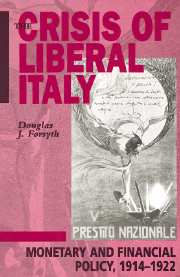Book contents
- Frontmatter
- Contents
- List of figures
- List of tables
- Acknowledgments
- Introduction
- Part 1 Giolittian Italy, 1901–1914
- Part 2 World War I, August 1914–November 1918
- 2 The collapse of the Italian fiscal system
- 3 The limits of state borrowing capacity
- 4 Monetary policy and the banking system
- 5 International accounts: Italy's loss of financial independence
- Part 3 The post-war crisis, November 1918–October 1922
- Conclusion
- Appendix: Tables and figures
- Bibliography
- Index
4 - Monetary policy and the banking system
Published online by Cambridge University Press: 11 December 2009
- Frontmatter
- Contents
- List of figures
- List of tables
- Acknowledgments
- Introduction
- Part 1 Giolittian Italy, 1901–1914
- Part 2 World War I, August 1914–November 1918
- 2 The collapse of the Italian fiscal system
- 3 The limits of state borrowing capacity
- 4 Monetary policy and the banking system
- 5 International accounts: Italy's loss of financial independence
- Part 3 The post-war crisis, November 1918–October 1922
- Conclusion
- Appendix: Tables and figures
- Bibliography
- Index
Summary
Monetary policy, 1914–1922
Italian monetary policy in the period between the outbreak of World War I and the March on Rome falls into three phases. The first phase lasted from the outbreak of war until approximately the end of 1914. During this time, monetary authorities were primarily preoccupied with restoring stability to the financial markets in the wake of the panic caused by the outbreak of war, and the breakdown in international payments and trade. During the second phase, which lasted until the end of the first post-war inflationary cycle in late 1920, monetary policy was largely subordinated to the exigencies of the Treasury. The issue banks were enlisted in support of war finance by favoring the placement of war loans, and by making direct advances to the Treasury. In the third phase, which lasted until the March on Rome, and indeed into the first months of 1923, the Bank of Italy was forced to respond once again primarily to the grave liquidity crisis experienced by industry and the banks, by assuming its responsibilities as lender of last resort, and guarantor of financial stability.
Phase 1: Domestic aspects of the financial crisis of July–August 1914
In Italy, as was the case elsewhere, panic enveloped the foreign exchange markets in the final week of July 1914, as the outbreak of war became imminent.
- Type
- Chapter
- Information
- The Crisis of Liberal Italy , pp. 125 - 148Publisher: Cambridge University PressPrint publication year: 1993



